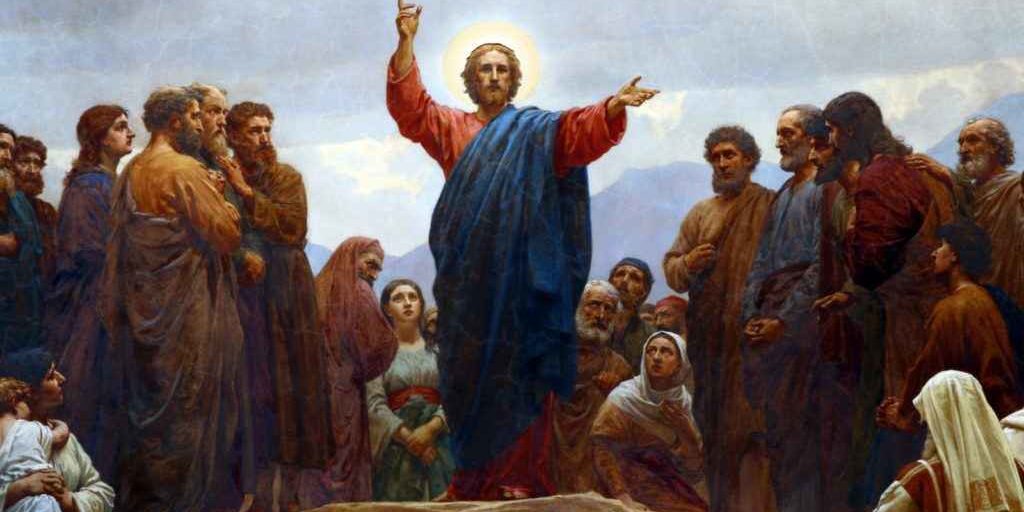
The Image and the Anti-Image
Theologians have traditionally understood the creation of Adam and Eve in the image of God in three distinct yet overlapping categories: king, priest, and prophet. Simply stated, to image God is to reflect his divine attributes. God imbues the first humans with certain qualities that he alone possesses. These qualities are both internal, or ontological, and external, or functional. God possesses certain qualities or attributes that he passes along to Adam and Eve—love, peace, justice, ability to rule, and so on. Adam is not God, nor does he perfectly mirror God in every way (Adam was not omnipresent). The line between Creator and creature is quite clear. As God’s image, Adam represents God on earth and is created to remain submissive to and wholly dependent on God. [1]
God charges the first couple to produce a kingdom of godly descendants, rule over the created order, embody and mediate God’s law to one another, and fill the earth with the presence of God (Gen 1:28; 2:15; 2:24). The fall fractures Adam and Eve’s relationship with their King and all of creation begins to rebel. In the midst of darkness, there is a ray of hope. Notice the grand promise of Gen 3:15
And I will put enmity
Between you and the woman,
And between your seed and her seed;
He shall bruise you on the head,
And you shall bruise him on the heel. (NASB)
The fate of the godly and the ungodly are intertwined. The godly are those who enjoy a restored image, whereas the ungodly are those who have a perverted image or an “anti-image.” The term anti-image, used throughout this essay, refers to an individual who is hostile to God and is the opposite of those who enjoy a restored image. The anti-image still retains all three offices of being in the image of God, yet it uses the offices for its own selfish ambition. Here the term anti-image is an apt description of the serpent’s seed. The two lines will wage war with one another, culminating in the decisive defeat of evil: “He [a righteous descendant of Eve] shall bruise you [the serpent] on the head.” Redemption is guaranteed. A godly king, who is in the pristine, perfect image of God, will vanquish the serpent, the embodiment of the anti-image, at the very end of history. All those who trust in this redeemer will inherit his victory.
In the Image of God or the Serpent
Immediately after partaking of the fruit, Adam and Eve “realized they were naked” (Genesis 3:7). The word here for “naked” (ʿērummim) is related to the Hebrew word for “crafty” (ʿrm) (Exodus 21:14; Joshua 9:4; Job 5:13). A few verses earlier, in Genesis 3:1, the serpent was described as “more crafty than any of the wild animals.” The point is that, as a result of the fall, the couple is beginning to take on characteristics of the serpent.[2] Instead of representing God on the earth, Adam and Eve are now beginning to represent the serpent. But God overcomes the first couple’s nakedness and hostility by graciously clothing them with his own inheritance (3:21).
From Genesis 4 to Revelation 20, the Bible narrates great hostility between those whose images are beginning to be restored and those whose images begin to collapse from within. Genesis 4–5 is paradigmatic for how the godly line and the ungodly line begin to interact with one another and fulfill the promise of Genesis 3:15. Genesis 4 opens with the birth of two children. Abel “kept flocks,” whereas Cain “worked the soil” (Genesis 4:2). Recall that Adam was responsible for both of these tasks (Genesis 2:15, 19–20), so we can surmise that Adam’s descendants are attempting to carry on the Genesis 1:28 commission. God may have rejected Cain’s priestly offering because it was taken from a “cursed” soil (Genesis 3:17). A godly king, who is in the pristine, perfect image of God, will vanquish the serpent, the embodiment of the anti-image, at the very end of history. Click To Tweet
Cain, like his parents, is confronted with two options: obey God and offer up an animal sacrifice from Abel’s lot (Genesis 4:4) or become wise in his own eyes and disobey God. The Lord tells Cain to function as a king, as he was created to do, and “rule over” sin (Genesis 4:7). Instead, sin eventually rules over him, and Cain murders his brother. We begin to see the image of God collapsing on itself, as Cain uses his royal identity for his own gain. Sin rules over Cain, and Cain wrongly rules over his godly brother Abel (cf. Genesis 9:6).
God approaches Cain, much liked he approached Cain’s parents in the garden, and asks him, “Where is your brother Abel?” (Genesis 4:9). Instead of speaking truthfully as a prophet should, Cain responds, “I don’t know.… Am I my brother’s keeper?” (Genesis 4:9). Up to this point, Cain has failed in all three offices: he offered up the wrong sacrifice (priest), ruled over his brother (king), and lied to God (prophet). As a result, Cain is sentenced to a life away from God in the “land of Nod, east of Eden” (Genesis 4:16). Adam is exiled from Eden, but Cain is farther still. He finds himself as a “restless wanderer,” estranged from the Lord (Genesis 4:12). Once again, exile from God’s glory is the penalty for disobedience. The story of Cain is the story of Adam and Eve.
The narrative then goes on to describe how Cain lives outside of God’s presence. According to Genesis 4:17, Cain built a city and then “named it after his son Enoch.” Building a city is a natural development of being in God’s image. God, according to Genesis 1–2, constructs a cosmic temple, so it’s not surprising that those in his image do the same. But Cain perverts his God-given responsibility as a priest and instead of building a city that brings glory to God’s name, he builds a city for the glory of his son Enoch. The habits of the anti-image are beginning to take root.
Nebuchadnezzar and the Coming Pristine Image
As the Old Testament unfolds, we learn more about the coming deliverer and how he will break the pattern of sin and rebellion and fill the earth with God’s glory with great finality. The coming of this righteous deliverer is central to the book of Daniel, especially, Daniel 2 and Daniel 7. The description of an end-time ruler in Daniel 2 is quite significant given the immediate context. The narrative in Daniel 2–3 describes one of the most grandiose examples of idolatry in the entire Bible. Nebuchadnezzar dreams of a colossus, and only Daniel can unlock the dream’s full interpretation. The statue is composed of four parts (Daniel 2:31–35), and each part symbolizes a particular kingdom (Daniel 2:36–44). The dream climaxes in the arrival of a “rock cut out of a mountain” that smashes the statue (Daniel 2:44–45). Despite being in a position to rule wisely over “all mankind and the beasts of the field and the birds in the sky” (Daniel 2:38; cf. Genesis 1:27–28), Nebuchadnezzar audaciously proceeds to construct the colossus in the following chapter.
The statue in his dream is composed of three different materials, and the head, symbolizing the Babylonian Empire, is manufactured out of gold. In Daniel 3, though, the entire image is made from gold! The golden image Nebuchadnezzar fashions symbolizes the magnificence and power of his kingdom. The parallels between Daniel 2–3 and Genesis 1–3 are staggering:
- In Genesis 1–2, God, as sovereign creator, fashions humanity in his image, whereas in Daniel 3, Nebuchadnezzar, as a false god, creates an image in his likeness.
- In Genesis 1–2, God creates Adam and Eve to mediate his rule over the earth, whereas in Daniel 3, Nebuchadnezzar is attempting to mediate his rule over the earth. (King)
- Genesis 1–2, God commands Adam and Eve to worship only him, whereas in Daniel 3, Nebuchadnezzar orders humanity to worship the statue. (Priest)
- In Genesis 1–2, God is the supreme fountain of truth, whereas in Daniel 3, Nebuchadnezzar claims to be the lawgiver. (Prophet)
Taken together, we can conclude that Nebuchadnezzar views himself as god, attempting to act like the creator of the cosmos. Someone made in God’s image (Nebuchadnezzar) creates an image of himself so that other images can worship him. Irony runs thick here. King Nebuchadnezzar is the anti-image par excellence. God, though, will not let such idolatry run rampant. Nebuchadnezzar will eventually be transformed into a grotesque beast (a symbol for his kingdom), the very thing he worshiped (Daniel 4:1–37; cf. 7:3–4). Meanwhile Daniel 2 predicts the arrival of a “rock cut out of a mountain,” a reference to the Messiah. Unlike the statue that is fashioned by humanity, this “rock” is pristinely fashioned by God. The long-awaited Messiah will be God’s instrument in overthrowing idolatry.
The Church and the Anti-People of God
The New Testament casts Jesus as the true people of God—the last Adam and true Israel. Possessing two natures, divine and human, Christ is in the pristine image of God. He is the faithful king, priest, and prophet, who successfully achieves the original commission to Adam and Eve. All those who trust in Christ inherit what he earned. Believers identify with his perfected image. But, while Jesus definitively vanquished the devil, the anti-image, the battle lingers. We see this graphically portrayed in the book of Revelation.
Juxtaposed with Christ’s and the church’s faithfulness in their threefold office, the ungodly or the anti-people of God use their threefold office for destruction. The ungodly image themselves on earth for their own glory. As anti-kings, the world wages warfare on God’s people through martyrdom and abuse (Revelation 11:7; 13:7). As anti-priests, the world attempts to defile the true temple, the church, and construct its own system of worship (Revelation 2:14; 9:21; 18:3). As anti-prophets, the world speaks lies and generates its own set of laws (Revelation 3:9; 16:13; 19:20).
The true church, however, executes its threefold office as king, priest, and prophet for the glory of God and the furtherance of the gospel. The true church images God on earth. As kings, the church imitates Christ by spiritually ruling over the world by becoming physically overcome by it (e.g., Revelation 2:7; 5:5; 11:7; 12:11). As priests, the church is depicted as a lampstand that enjoys God’s glory and radiates it to a hostile world (Revelation 2:1, 5; cf. 11:4). And as prophets, the church bears witness to God’s truth at all costs, just as Christ bore witness (Revelation 1:2, 5, 9; 6:9; 11:3; 12:11). As we the church, those who have put on the restored image of Christ, journey through the difficult terrain of life, we must never lose heart. God calls us to image him faithfully in all our thoughts and actions, and it is by trusting in his promises that we overcome the devil and all those allied with him.
Endnotes
[1] This essay is an adaption of portions of Benjamin L. Gladd, From Adam and Israel to the Church: A Biblical Theology of the People of God (Essential Studies in Biblical Theology; Downers Grove, IL: IVP Academic, 2019).
[2] Meredith G. Kline, Genesis: A New Commentary, ed. Jonathan G. Kline (Peabody, MA: Hendrickson, 2016), 22.

